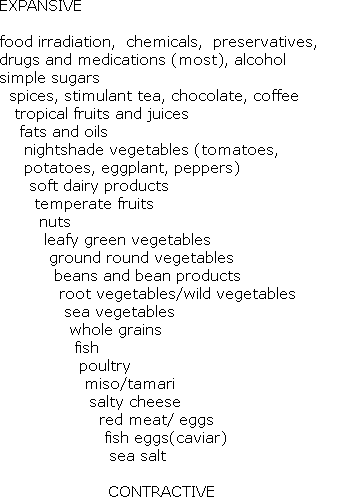 |
|
 |

Macrobiotic diet basics,
Page 4 of 9
Expansive or Contractive?
Energy is the Life Force in the universe and seen everywhere in nature. In Chinese it's called 'chi', in Japanese it's 'ki', and in Hindu it's 'prahna'. In the West we describe it as electromagnetic charge, vibration, or bio-energy.
We experience this energy most clearly in its manifestations of its two opposties: Contractive forces and Expansive forces, i.e. hot and cold, active and relaxed, night and day. Distinguishing these forces around us and within us, helps us 'use' this energy.
Characteristics of opposing yet complimentary forces:
| YANG
Contractive
Hot/Warming
smaller
near the equator
Summer
more heat
more salt
more pressure
more time
sodium
grow below soil
most fish, sea veg's
extreme: salts and meats
stews/baking/
pressure cooking
focused and concentrated
extreme: "tight"/stressed
|
YIN
Expansive
Cold/Cooling
larger
near the poles
Winter
less heat
less salt
less pressure
less time
potassium
grow above soil
whole grains, vegetables, temperate fruits
extreme: tropical fruit, sugars and chemicals;
fresh and raw
foods
creative and
relaxed
extreme: forgetful/unable to complete projects
|
In cooking, we use this awareness to determine which whole foods are prepared for a balanced strong meal.
For example, the hot/warm (Yang) temperatures of Summer are balanced by light cooking, fruits and raw vegetables (Yin). In the cold Winter (Yin) we pressure cook and bake (Yang).
Maybe a more dramatic example is the heat in tropical climates (Yang) being balanced by the watery fruits (Yin) that grow there. Tropical fruits support the expansion of pores to keep the body cool. If tropical fruits (Yin) are eaten in a Winter climate (Yin), the person often feels too cold (Yin).
Similarly, the people living near the freezing North Pole (Yin) eat mostly animal foods (Yang) to stay warm and 'contracted'. If someone is living in a hot (Yang) climate and they eat a lot of animal protein (Yang) they might find themselves too 'contracted' and uptight (Yang).
If someone is very 'tight' and stressed (Yang) and not able to relax (Yin)...better to eat a diet focusing on whole grains, vegetables and fruits (Yin) to balance rather than a diet high in salty meats (Yang).
Or if someone is too 'spacey' and forgetful (Yin)....they can balance by eating more grounding root vegetables and whole grains and fish (Yang) rather than sugar and fruit juices (Yin).
This understanding is also very helpful when it comes to health challenges. If a person wakes up with expanded swollen glands (Yin) in the throat....it's better to eat a 'contractive' miso soup (Yang) to balance rather than tropical fruit (Yin).
Through these simple examples we can see how understanding the energetics of food can have a very dramatic effect on health, vitality and behavior.
All food is either contractive or expansive in its effect.
The goal is to become familiar with these different energy classifications so we can 'use food' to support our health and vitality.
Foods are classified according to:
- how the food grows (including speed and direction);
- where the food grows (in northern or southern climates);
- the sodium - potassium content;
- the effect the food has on the body;
The classification of a food is relative to other food categories and to foods within its own category. For example, within the category of nuts, Brazil nuts are more 'expansive' than hazelnuts; buckwheat is more 'contracted than barley; watermelons are more 'expansive ' than berries.
The following list will give you a basic idea of the classifications. In general, foods chosen from the middle of the list (fish to temperate fruits) are appropriate for a person living in a temperate climate in good health. To maintain balance, the foods near the extremes are used in very small portions (sea salt) or avoided (chemicals,drugs).

Next: After studying nature's opposites, we now look at how nature flows between these opposites 

|
 |




